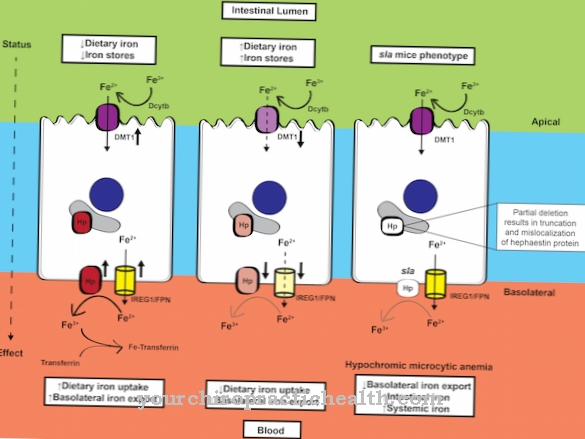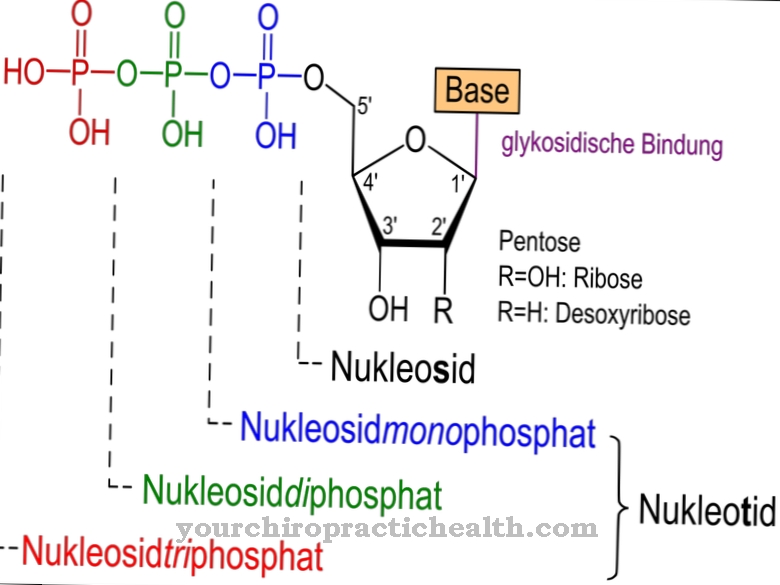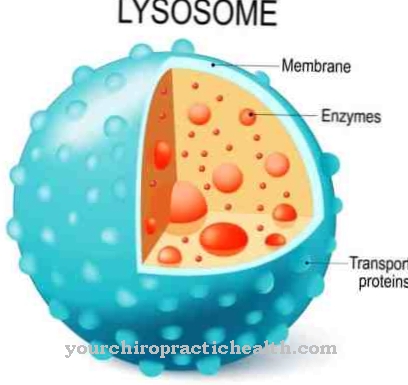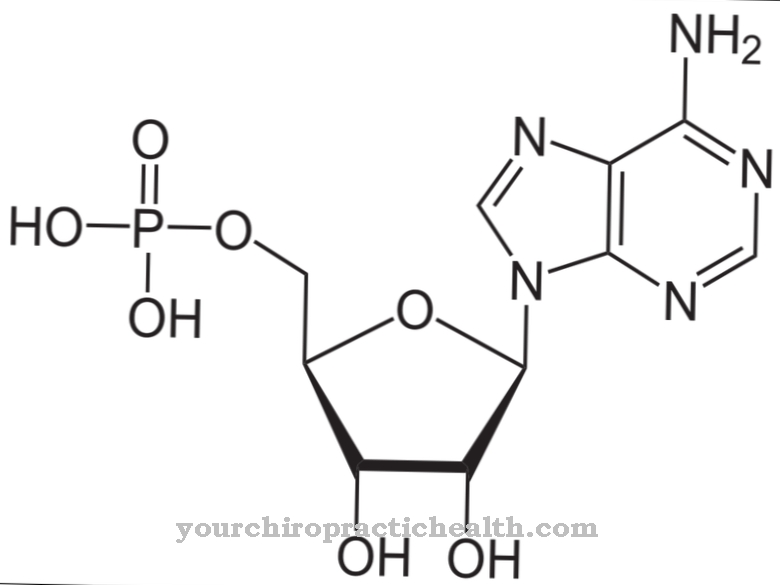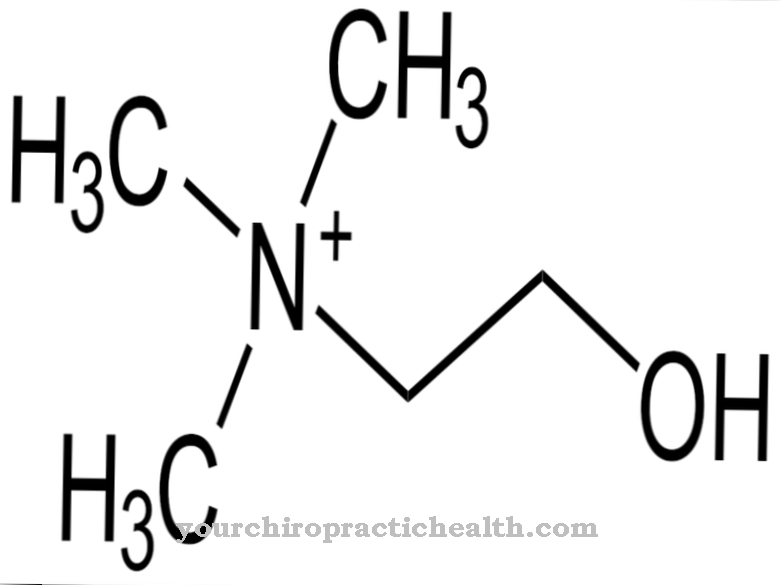Guanine is an important nitrogen base and is of central importance for the nucleic acid metabolism in the organism. It can be synthesized in the body from amino acids. However, due to the high energy expenditure of this reaction, it is often recovered via the salvage pathway.
What is guanine?
Guanine is one of the five nitrogen bases that play a key role in the structure of DNA and RNA. It is also a basic component of other physiologically important molecules such as guanisine triphosphate (GTP).
Guanine is a purine base, the basic chemical structure of which consists of a heterocyclic aromatic ring made up of six atoms and an attached five-membered ring. In the body it usually occurs as a mononucleotide with ribose or deoxyribose and a phosphate residue. In addition to ATP, the mononucleotide GTP is an energy store in the context of energy metabolism. In the double helix of DNA, guanine is linked to the complementary nitrogen base cytosine via three hydrogen bonds.
Since the formation of free guanine is very energy-intensive, it is recovered in the body from the nucleic acids by splitting off (salvage pathway) and used again in the form of a mononucleotide for nucleic acid synthesis. It is broken down into uric acid in the body. Guanine is a slightly yellowish-looking solid with a melting point of 365 degrees. It melts with decomposition. It is insoluble in water, but can be dissolved in acids and alkalis.
Function, effect & tasks
Guanine is part of nucleic acids and various nucleotides and nucleosides. As an important nucleobase, it is one of the central molecules of all organisms.
It forms the genetic code with the other three nucleobases adenine, cytosine and thymine. Like these, it is glycosidically bound to the sugar deoxyribose in DNA. Three successive nucleobases encode one amino acid each as a so-called codon. Several codons thus code a protein as a chain of consecutive amino acids. The genetic code is stored in the DNA. Within the double helix of the DNA there is a complementary chain with the respective complementary nucleobases. It is linked to the codonogenic chain by hydrogen bonding and is responsible for the stability of the genetic information.
Within the RNA, guanine, along with the other nucleobases, plays an important role in protein synthesis. The nucleosides guanisine and deoxyguanisine are also important intermediate products in metabolism. Furthermore, the nucleotides guanisine monophosphate (GMP), guanisine diphosphate (GDP) and guanisine triphosphate (GTP) are responsible for the energy metabolism in addition to ATP and ADP. The nucleotides of DNA also occur as intermediate compounds in the metabolism.
Education, occurrence, properties & optimal values
Guanine is of central importance in the metabolism of all organisms. Since it is part of the nucleic acids, it also occurs freely as an intermediate product of the metabolism. In the human organism it can be synthesized from amino acids. However, the biosynthesis is very energy-intensive.
It is therefore recovered from the nucleic acids in the form of a nucleotide via the salvage pathway. In the salvage pathway, free purine bases such as adenine, guanine and hypoxanthine are cut out from existing nucleic acid and new mononucleotides are formed. This process is much more energy efficient than the new synthesis of guanine and its mononucleotide. The mononucleotide is used again for nucleic acid synthesis. The salvage pathway thus represents a recycling process. When guanine is broken down, uric acid is produced via the intermediate product xanthine.
The breakdown of purines in the body is the main source of uric acid. In birds, reptiles and bats, guanine is an important excretion product for nitrogen in addition to uric acid. Since this pasty product contains little water and can only be used poorly for energy generation, it is excreted directly by birds and bats in particular. Because the total mass is reduced when it is excreted, the ability of these animals to fly improves. The excreted guanine forms what is known as guano, especially on lime-rich soils after weathering. Guano is a very valuable fertilizer rich in phosphorus and nitrogen.
You can find your medication here
➔ Medicines for muscle weaknessDiseases & Disorders
If the guanine metabolism is disturbed, health problems can arise. For example, if the enzyme hypoxanthine guanine phosphoribosyl transferase (HGPRT) is defective, the salvage pathway is disrupted. The so-called Lesch-Nyhan syndrome develops from this.
In this disease, the recovery of guaninsine mononucleotides from the nucleic acids is insufficient. Rather, there is an increased breakdown of guanine. Large amounts of uric acid are produced in the body. This is why this disease is also known as hyperuricemia syndrome. In severe cases, autoaggression, cognitive impairment and even foreign aggression occur. Often the patients injure themselves. Boys are mostly affected because the autosomal recessive disease is caused by a gene mutation on the X chromosome.
In girls, both X chromosomes should be affected by the mutation, but this rarely happens. If Lesch-Nyhan syndrome is left untreated, children die in infancy. The breakdown of guanine can be inhibited through the use of medication and a special diet. The symptoms can thus be partially alleviated. Unfortunately, the Lesch-Nyhan syndrome cannot be treated causally. Hyperuricemia can also occur in connection with other diseases or other genetic defects. Primary hyperuricemia is one percent genetic and 99 percent caused by decreased uric acid excretion through the kidneys.
There are also secondary forms of hyperuricemia. For example, diseases that are associated with increased cell deterioration such as leukemia or certain blood diseases can produce more purines and thus uric acid. Medicines or alcoholism can also lead to disorders of the purine metabolism. As a result of increased uric acid concentrations, gout attacks can occur due to uric acid precipitates in the joints. The treatment includes a diet that is low in purine and therefore also low in guanine.


